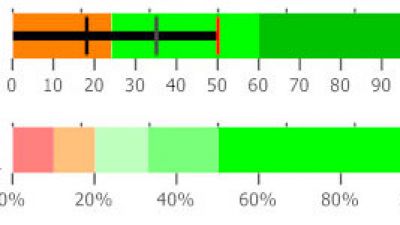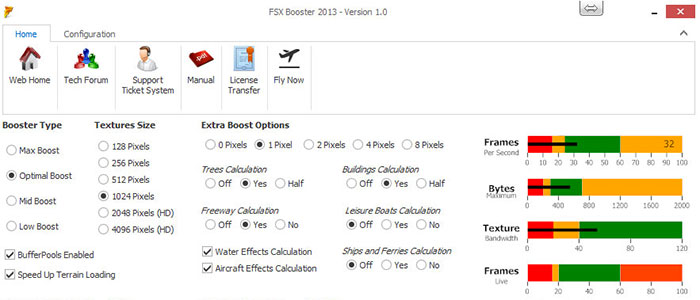
FSPS FSX Fiber Accelerator Performance Booster for FSX Released
Flight sim devotees can now enjoy FSPS’s FSX Fiber Accelerator, a refined performance enhancer that dynamically adjusts the fsx.cfg in…

Like many people, we’ve spent a lot of time (probably too much) trying to get my FSX to work at the very highest level of performance possible. It’s something that every user will find themselves doing at one point as one change or another can seemingly make your graphics much better, or your flights much smoother. Whatever the remedy to your problems is, you’ll usually find that the solutions out there can be quite varied. Some recommend manual configuration changes, others recommend a specific product.
One product on the market at the moment that is supposed to have everything that you need to fix your FSX performance troubles is the FSPS' FSX Booster 2013. Released two years ago, it’s been a popular choice for people who gave it the time to settle – numerous bugs and problems held back its initial release being an all-out success, but a range of patches have helped to sort these problems out and provide something far more akin to what was supposed to be offered up in the first place.
So, we installed the FSX Booster 2013 on a fresh copy of FSX, on a machine that was having a bit of trouble with the simulator and performance was nothing like what we were hoping/expecting for. This additional support tool, then, was supposed to be our route to success and flashy performances – so did it live up to its expectations?
The fifth in the line to the throne of the FSX Booster lineage, this product was created with the intention of offering a much needed bit of assistance to those who were using older machines (like us!) and were suffering from choppy frame rates and an overall poor level of frames per second throughout the flight.
The entire idea behind what was released was simply to offer a more dynamic and user-friendly process that would make sure performance would be improved without needing a great deal of input from the user individually. This makes a great deal of sense, as many simulation users aren’t quite prepared to dive into the configurations.
If you are interested in using this product with other simulators, by the way, you’ll be happy to know that the developers have recently created a release for the Lockheed Martin’s Prepar3D simulator as well.
The product itself says that it can give you up to double, or 200%, of the original frames that you would have seen alongside improving your frame rate by as much as 30%. Whilst we’ll be a bit more specific later on about the product and its capacity, we have to admit that even on the lower end machine that we were using; we never noticed this massive growth in capacity or performance.
What we did see, though, was a genuine difference in the level of performance that was more than noticeable – however, we’ll look at that in more detail later on.
The software itself, though, is built to make a large amount of incremental changes to the configuration and the settings of your FSX software and make it run at a higher level than previously. Basically, it’s made for those who want the option of making changes themselves of if they want to just leave it to the software to find the right route to detail and design. The one thing that I was really impressed by in all of this, though, was the ease of which the software was to use – in terms of setting it up to do its job, it was incredibly easy.
Another big touch for the software is the ability to manipulate and change graphic settings. This allows you to load autogen objects of a specific size, allowing you to make sure only the bigger parts of the scenery are going to load up as you fly. This can obviously improve performance as well, so it’s a nice feature to have in there for anyone who suffers from stuttering when the things around them are being automatically generated.
It removes a lot of the smaller things that – being honest – you can do without if you are not using some high-end scenery packages, whilst making a rather significant increase to the performance at the same time. For that reason alone, it would be worth having this installed on your machine. Basically, the software wants to add a bit of extra choice to the proceedings for you whilst also ensuring that you can boost the performance in some capacity regardless.
Please be aware that going too far in the performance route via the graphics options can more or less absolutely tank your overall quality and looks throughout the simulator, removing a big part of the appeal.
Well, it all depends on two things. The software brings a lot of changes in the background that work on improving the frame rates but the levels being discussed aren’t quite up to the standard that we were expecting or told to be expecting. However, this is mitigated by quite a few factors that are worth considering;
The software itself has helped other members on individual machines that were of a lower quality to the machine that we were using – it seems to have a more dramatic effect on machines that are having absolutely chronic FPS problems. However, for machines that can already maintain a strong level of 20-30FPS throughout, it won’t make anything like a 30% difference unfortunately
Therefore, if the software is used on a higher end machine that can already boss FSX with plenty of add-ons and all the bells and whistles at the highest point, chances are that it won’t work for you as well as it was supposed to
We found there to be a difference of a few FPS in some cases – especially with aircraft that were billed as rather slow on the FPS rating. Some aircraft cram a lot in there, and it was easy to spot the difference on the “fatter” aircraft that brought more to the party, so to speak. However, the level seemed to decrease in its effectiveness as we used lighter aircraft more often to see how the performance would hold out.
The software, then, definitely does what it says on the tin – it does boost your performance. However, it only seems to give you the 30% ratings spoken about on old machines that are chugging along and are using aircraft that are really heavy – if you are already getting a smooth flight on a solid machine, you probably won’t get the same level of difference as advertised.
Given the fact that two config settings which are identical can cause a totally different output from machine to machine and mod to mod, it’s hard to say if the software is quite as good as it was stated or not. Whilst we noticed a big range of improvements in the past from this software, our test machine – which was about mid-level at best – did not really get the depth of improvement we neither expected nor experienced in the past.
We wanted to look a bit further in to what was actually being changed but – as we note below – it’s a bit hard to see the mass of changes. Given that the software makes the changes independently and dynamically for you, it’s a bit tough to say that it made X change or Y adjustment. Instead, it just does things that seem to be the best fit for your problem. The big problem here, then, is the fact that simulators are extremely temperamental pieces of kit that can be challenging to get to work as you had originally intended.
We found that, under the hood, many of the changes that were being made were fairly routine within the world of FSX configuration mods and boosters. The main benefit here, though, was the fact that it managed it all itself – we never really had to do too much outside of play around with some extra graphical settings. Other boosters still ask for input that is simply beyond some users own knowledge, so this was far easier to use than some of its contemporaries – however, the upgrades weren’t quite what was expected.
Basically, if you are using a good machine this won’t make it even better.
One thing that we found – and many others have agreed with – is that there is a significant problem with the fact that everything is being hidden behind an interface. Given that the end result is a range of extensive changes to FSX configuration settings and variables, the lack of explanation and understanding of what is going on can be quite baffling. The main criticism we found from our more advanced members as well as members of the community was this exact problem; it tries to make the complexity of the changes seem even more complex by hiding them under the interface.
However, the product is suggested as a user-friendly suggestion so perhaps it’s a bit churlish to expect both detailed and advanced answers as well as wanting something that those without the editing mind or time to do so can make good use of at one stage. The main problem with the mod, though, is definitely the visibility of the changes – given that some people (ourselves included with this test machine) never witnessed the level of changes that were promised, it would be nice to be able to see what was being changed to see if further, more advanced, tweaks could have been made on our own.
The first thing to realize when using this software, then, is that it’s not the Messiah – but it’s not a naughty boy, either. It’s very easy to use and it sets everything up more or less in an automated manner for you. It’s a very useful piece of kit for those who aren’t sitting with a high-end gaming machine and perhaps have just gotten into the world of flight simulator. If your machine needs a bit of an upgrade, then it might work out best for you to start using this in the interim – it makes a significant difference in that circumstance.
For those who on the lower end of the machine spectrum this will definitely chip in and give you a nice performance boost, especially with the more challenging side of running FSX with add-ons and expansive aircraft. You might only get a few extra frames, though, if you are a bit further up the ladder – towards the top of the chain, the improvements are more or less negligible. However, there is only a specific limit as to what you will be likely to get from FSX due to engine limitations of the software etc. so if you are near the top, you can only hit that specific limit, really!
Our overall impressions then were that this was a solid enough product that probably isn’t as universal as it would have hoped. There are critics who say they can get better performance by making some changes themselves, whilst others will completely swear by it – everyone in our team, though, found it to be a nice enough little addition without adding TOO much to the party on various different machines. The one that we used to test it on, for example, got an increase of perhaps 10% instead of the 30% we had hoped for.
However, on a machine that is on its way out and would be best being read its last rites, you might just be able to eek that 30% out. It does provide a totally personalized and formal performance appraisal of your machine, though, so it’s not just a config file with a price tag flung on the front. It’s very useful but, again, if you are hammering away in the sky in the high 50s for frame rate then you aren’t really going to eek too much more out of the simulator with this mod.
For the price, though, it can be a brilliant budget option whilst you save up for a new machine or some extra RAM and a new graphics card!
 Don't forget... We have a huge selection (over 24,000 files) of free mods and add-ons for MSFS, FSX, P3D & X-Plane in the file library. Files include aircraft, scenery, and utilities All are free-to-download and use - you don't even need to register. Browse on down to the file library here.
Don't forget... We have a huge selection (over 24,000 files) of free mods and add-ons for MSFS, FSX, P3D & X-Plane in the file library. Files include aircraft, scenery, and utilities All are free-to-download and use - you don't even need to register. Browse on down to the file library here.
0 comments
Leave a Response